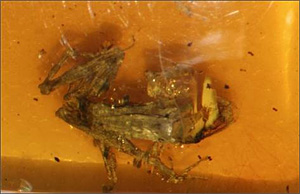 |
 |
 |
 Editorials | Environmental | February 2007 Editorials | Environmental | February 2007  
Frog in Amber May Be 25M Years Old
 Associated Press Associated Press


| | A miner in the state of Chiapas found a tiny tree frog that has been preserved in amber for 25 million years. |
A miner in the state of Chiapas found a tiny tree frog that has been preserved in amber for 25 million years, a researcher said. If authenticated, the preserved frog would be the first of its kind found in Mexico, according to David Grimaldi, a biologist and curator at the American Museum of Natural History, who was not involved in the find.

The chunk of amber containing the frog, less than half an inch long, was uncovered by a miner in Mexico's southern Chiapas state in 2005 and was bought by a private collector, who lent it to scientists for study.

A few other preserved frogs have been found in chunks of amber - a stone formed by ancient tree sap - mostly in the Dominican Republic. Like those, the frog found in Chiapas appears to be of the genus Craugastor, whose descendants still inhabit the region, said biologist Gerardo Carbot of the Chiapas Natural History and Ecology Institute. Carbot announced the discovery this week.

The scientist said the frog lived about 25 million years ago, based on the geological strata where the amber was found.

Carbot would like to extract a sample from the frog's remains in hopes of finding DNA that could identify the particular species, but doubts the owner would let him drill into the stone. 'I don't think he will allow it, because it's a very rare, unique piece,' said Carbot.

Grimaldi of the American Museum of Natural History called the idea of extracting DNA 'highly, highly unlikely,' given that - as other scientists have noted - genetic material tends to break down over time.

But George O. Poinar, an entomologist at Oregon State University who founded the Amber Institute, said extracting DNA is theoretically possible.

'If it's well-preserved ... and none of the frog has been exposed to the outside, where air could enter in and oxidize the DNA, it could be possible to get DNA.' | 
 | |
 |



